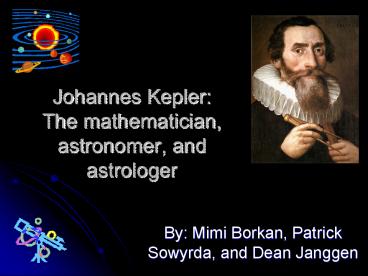Johannes Kepler: The mathematician, astronomer, and astrologer - PowerPoint PPT Presentation
Title:
Johannes Kepler: The mathematician, astronomer, and astrologer
Description:
Johannes Kepler: The mathematician, astronomer, and astrologer By: Mimi Borkan, Patrick Sowyrda, and Dean Janggen The Life of Kepler Kepler was born on December 27 ... – PowerPoint PPT presentation
Number of Views:122
Avg rating:3.0/5.0
Title: Johannes Kepler: The mathematician, astronomer, and astrologer
1
Johannes KeplerThe mathematician, astronomer,
and astrologer
- By Mimi Borkan, Patrick Sowyrda, and Dean Janggen
2
The Life of Kepler
- Kepler was born on December 27, 1571 in Germany.
- He attended the University of Tübingen in
Germany. - Kepler observed major astronomical events as a
child including the Great Comet of 1577 and the
lunar eclipse of 1580. This influenced his
interest in astronomy. - As a child, Kepler suffered smallpox which left
him with weak vision and crippled hands leaving
him unable to do what he loved most observe
astronomy. - He died on November 15, 1630, in Germany, at the
age of 68.
3
Achievements
- Kepler was a key figure in the 17th century
scientific revolution. - Keplers main works of literature were about
astronomy, however he also wrote smaller articles
on the topics of mathematics, and astrology,
areas he also enjoyed studying. - Kepler is most commonly known for his laws of
planetary motion which provided foundation for
Isaac Newtons theories. - Some of Keplers other accomplishments include
providing a new and correct account of how vision
occurs, developing a novel explanation for the
behavior of light in the newly invented
telescope, and many more!
4
First Law of Planetary Motion
- The orbits of the planets are ellipses, with the
Sun at one focus of the ellipse. - The planets do not move in perfect circles, but
rather in oval shapes called ellipses, using the
sun as one focus.
5
Second Law of Planetary Motion
- The line joining the planet to the Sun sweeps out
equal areas in equal times as the planet travels
around the ellipse. - When a planet is closer to the sun it will move
at a faster pace. If two planets move for an
equal interval of time, the area that they cover
will be equal no matter where they are in the
ellipse.
Perihelion closest point to the sun Aphelion
farthest point from the sun
6
Third Law of Planetary Motion
- The ratio of the squares of the revolutionary
periods for two planets is equal to the ratio of
the cubes of their semi-major axes - Since we know the length of its orbital period,
or year, we can determine the mean distance of a
planet from the sun.
This animation demonstrates Keplers third law.
http//www.pd.astro.it/education/PlanetV/images/2O
RBITE.GIF
7
Bibliography
- http//csep10.phys.utk.edu/astr161/lect/history/ke
pler.html - http//en.wikipedia.org/wiki/Johannes_Kepler
- http//en.wikipedia.org/wiki/Kepler27s_laws_of_pl
anetary_motion - http//www.britannica.com/EBchecked/topic/315225/J
ohannes-Kepler































